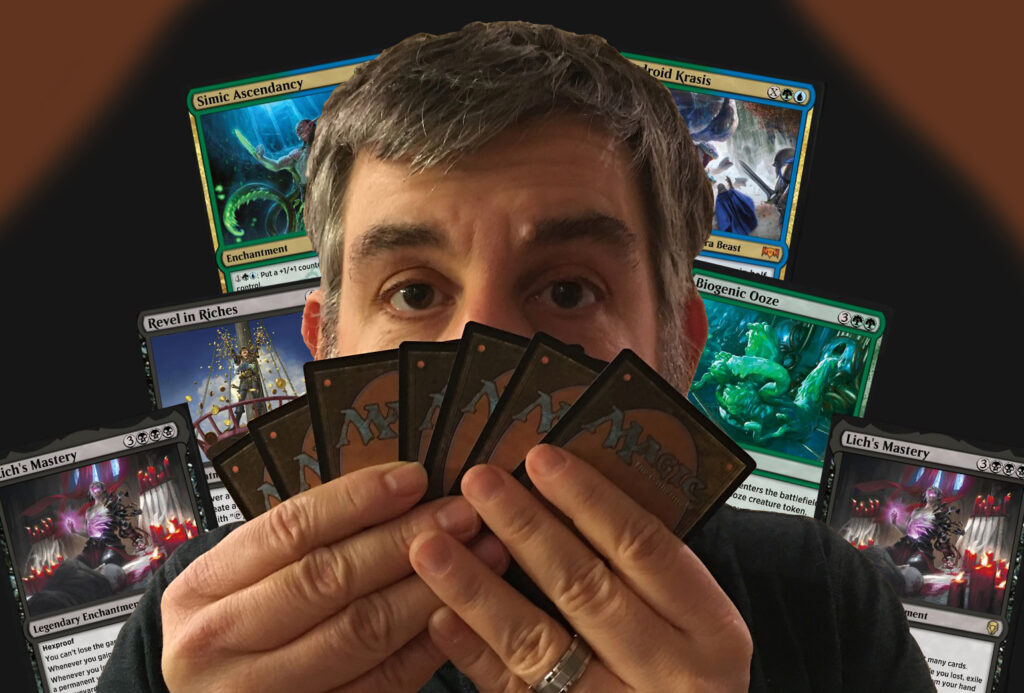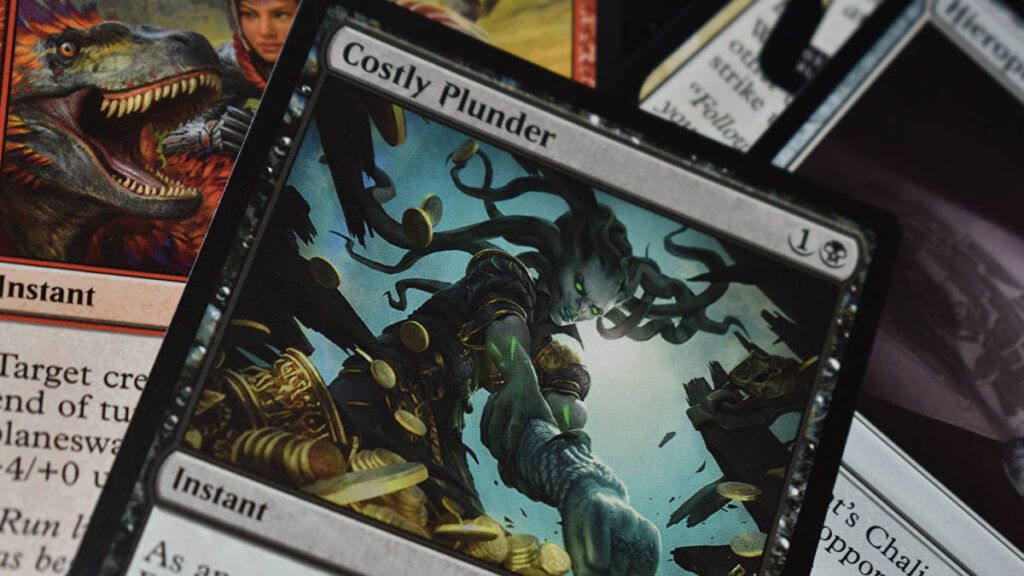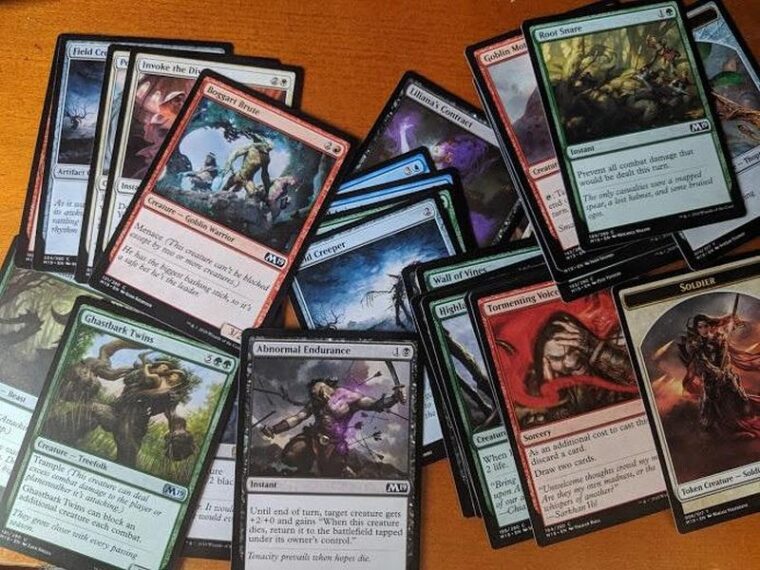What is Magic?
Magic: The Gathering is the world’s first trading card game, first released in 1993 by Wizards of The Coast. It’s a game built around mythical creatures, enchantments, artifacts, and other fantasy focused ideas, where you cast spells to get your opponent’s life total down to zero. From my experience, it’s a game that you’re either obsessed with or stay well clear of—sort of like Dungeons & Dragons. Nevertheless, Magic has received widespread success and praise all around the globe, which I believe can be accredited to several desirable selling points.
Selling Point #1:
Firstly, the gameplay. Magic The Gathering is a card game lover’s dream. The mechanics are complex yet understandable and rewards players that think before they take their turn. The game also allows and encourages players to build their own decks, meaning no two games are the same. As long as you’re collecting new cards, gameplay will never become stale. There’s always a new mechanic or strategy to learn!
There are also thousands upon thousands of ways to play the game, enabling players to get creative and build a deck that suits their play style and personality. There are unique formats for different playstyles, that facilitate 1v1s, teamwork, and free-for-alls. Popular formats include Commander (100 card deck), Standard (60 card deck for only the newest cards), Vintage (60 card deck where just about anything goes), and numerous others.

Selling Point #2:
Secondly, there’s the thrill of buying Magic cards. Cracking a pack of Magic The Gathering cards is essentially the card game equivalent of a scratchie. Normal packs always contain at least one rare card, and if you’re lucky, that card alone will pay for the price of the pack. For perspective, the most expensive card in Standard right now is selling for around $50, and the price of a pack is about $6. If we turn back the clock to open packs from the 90s, card prices skyrocket. The most expensive card, Black Lotus, recently sold for $511,100. As a result, magic cards have become a highly sought after collectable.
Selling Point #3:
Thirdly, Magic is a game for collectors. Even if you ignore the gameplay, Magic: The Gathering cards hold merit for their incredible artworks and design. High-profile artists such as Rebecca Guay and John Avon consistently produce stunning artwork for Magic cards, elevating the game’s visual quality. Cards come in many collectable forms, from foil coating, to borderless frames, to art that takes up the whole card. Standout features such as these make them a sight to behold and treasure for those with a collector’s eye. Like Pokemon (gotta catch ‘em all), the idea of collecting all makes for an entertaining adventure, with plenty of visual stimulation for your efforts.
These three selling points have more or less been around since the game’s inception. So, why is Magic: The Gathering seeing a resurgence today? I believe three key causes have opened up the wondrous world of Magic to new audiences.

Post Malone
A month ago, highly decorated superstar/artist Post Malone appeared on a Magic: The Gathering YouTube series titled Game Nights. Unsurprisingly, the A-list celebrity brought thousands of new eyes to the game, where they could witness the joys of a friendly, competitive Magic game. But, unfortunately, one of Magic’s biggest barriers to growing its audience is the perception that it’s a game only for ‘nerds’.
By playing Magic, Post Malone showed that it’s a game for everyone, greatly assisting in breaking down these preconceived ideas about the game, potentially withholding a new player from investing. Not to mention, most of Post Malone’s fanbase are young adults and teenagers, giving Magic a window into the newest generation.
Logan Paul
Post Malone isn’t the only big name out there that recently showed admiration for card games. YouTube phenomenon Logan Paul has begun collecting Pokemon cards, very much highlighting the value and investment opportunities that appreciating cards bring. Although Pokemon isn’t Magic, and Logan Paul isn’t exactly a redeemable figure, the amount of exposure brought to the game of trading card games cannot be ignored. Logan even went as far as to wear his $193,000 Pokemon Card to a heavyweight boxing match with Floyd Mayweather.
What does this mean? The value of collectable trading cards isn’t an underground community anymore. Instead, the western world has been exposed to the phenomenon, and if it takes their fancy, Magic: The Gathering is an extremely viable option.

A mobile version
While the high value of Trading Cards does appeal to collectors, it makes playing the card game a costly endeavour. To play in formats with a competitive deck, a player would need to spend hundreds, sometimes thousands, to stand a chance.
This is why I believe the Magic: The Gathering creators have been advertising their mobile and PC game MTG Arena constantly. MTG Arena allows you to play against others, anywhere, anytime. The game also provides you with a substantial amount of strong cards for free so that you can build a competitive deck without breaking the bank. MTG Arena also boasts a carefully constructed tutorial that’s gentle and useful to new players who are just dipping their toes into the complex, historic game.
Summary
If we combine Magic: The Gathering’s long-standing selling points with its recent encounters in pop culture, as well as the accessibility of the mobile version, it’s understandable to see why the game is becoming more popular than ever. No matter how you play or collect, there’s something for everyone in magic, whether it be the artwork, the gameplay, or merely the thrill of cracking open packs.
For more gaming content, news, and popular culture discussions, check out HappyMag.
